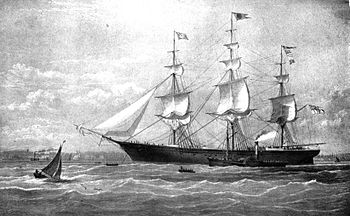James Baines (clipper)
 |
|
| History | |
|---|---|
|
|
|
| Namesake: | James Baines, ship owner |
| Owner: | James Baines & Co. |
| Ordered: | 1853 |
| Builder: | Donald McKay, East Boston |
| Laid down: | 1854 |
| Launched: | 25 July 1854 |
| Christened: | 25 July 1854 by James Baines |
| Commissioned: | 12 September 1854 |
| Out of service: | 22 April 1858 |
| Homeport: | Liverpool |
| Fate: | burned, rebuilt as a coal barge, final fate unknown |
| General characteristics | |
| Class and type: |
|
| Tonnage: | 2,275 GRT |
| Displacement: | 2,515 tons (2,555 tonnes) at 29 ft (8.8 m) draught (1.000 tons ship mass + 1.455 tons cargo & passengers' mass) |
| Length: |
|
| Beam: | 44 ft (13 m) |
| Draught: | 29 ft (8.8 m) loaded |
| Propulsion: | Sails |
| Speed: | 21 kn (39 km/h) on June 17, 1856 at 44°S, 106°E; best 24-hour run: 342 nmi (633 km) in 1854 |
| Boats & landing craft carried: |
6 lifeboats |
| Capacity: | 1,400 tons cargo + 700 passengers |
| Complement: | 100 crew |
The James Baines was a passenger clipper ship completely constructed of timber in the 1850s and launched on 25 July 1854 from the East Boston shipyard of the famous ship builder Donald McKay in the United States for the Black Ball Line of James Baines & Co., Liverpool. The clipper was one of the few known larger sailing ships rigged with a moonsail.
Ship builder Donald McKay laid all his skills and professional experience in the construction of this passenger carrying clipper ship, small faults that had been detected by him before in the sister ships were fixed during the building of the James Baines. Regarding her lines, stem, and bow, she was not as sharp and hollow-lined as her sister ship Lightning or as "full" as her other sister ship Champion of the Seas. The ship's main frame was of white oak, the ceiling, planking, deck-frames and keelsons, of hard pine. The ship's hull was diagonally braced with iron, and square-fastened, and all the keelsons and waterways are scarphed and keyed. It was said in her time the style in which the James Baines's hull was designed and built, both inside and outside, has not been surpassed or equalled, by any other ship Donald McKay has ever constructed. The stern and the bow including the cutwater were beautifully adorned with gilded carvings, the ship's hull was painted black with blue waterways and a blue underwater ship. Her mast-heads and yards were black and equipped with iron caps, the hoops on her masts were held in white as well as the deck houses and rails. On Mr James Baines order the ship was equipped and fitted with the best and most modern ship improvements (pumps, windlasses & winches, Crane's self-acting chain-stoppers (invented in 1852)).
As she was built for a passenger shipping line she provided luxury (1st class) accommodations equipped with the finest furniture available and mahogany panelling (wainscots), furthermore with standard rooms for the transportation of 700 passengers. The ship had also state-rooms and dining-rooms of the finest design. Three decks, a poop deck, two deck houses and a topgallant forecastle provided the accommodations for three classes of passengers and the 100 men crew whose bunks were built in the forecastle and in a deck house abaft the foremast. The ladies' cabin was in the stern section (aft) as well as the captain's rooms, the gentlemen's rooms were amidships to the ships's sides. All passenger and crew rooms were well ventilated and provided with sufficient light. The James Baines was not only a beautiful but also a very fast ship holding still sailing ship records as that of her first voyage from Boston to Liverpool.
...
Wikipedia
